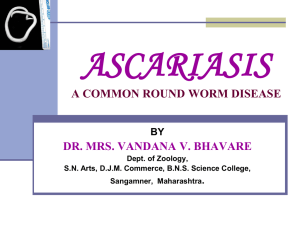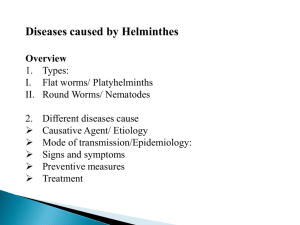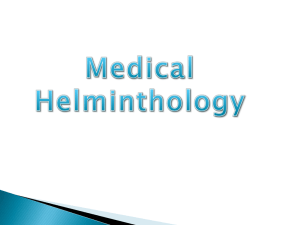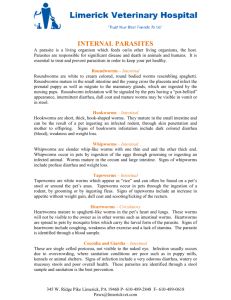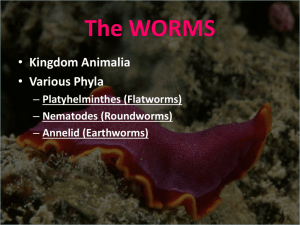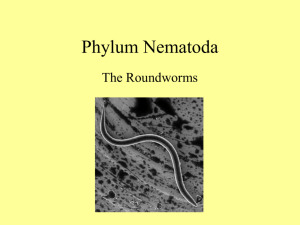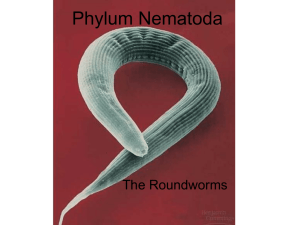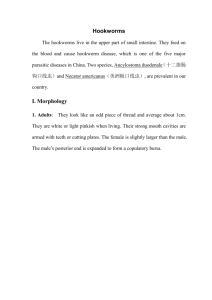Tropical Infection Diseases
advertisement
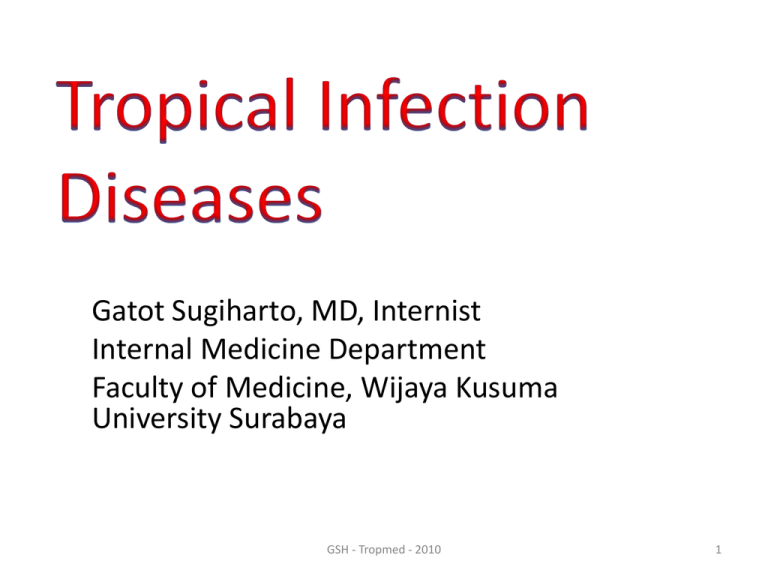
Gatot Sugiharto, MD, Internist Internal Medicine Department Faculty of Medicine, Wijaya Kusuma University Surabaya GSH - Tropmed - 2010 1 Gatot Sugiharto, MD, Internist Internal Medicine Department Faculty of Medicine, Wijaya Kusuma University Surabaya GSH - Tropmed - 2010 2 HIV Testing • Blood Detection Tests – Enzyme-Linked Immunosorbent Assay/Enzyme Immunoassay (ELISA/EIA) – Radio Immunoprecipitation Assay/Indirect Fluorescent Antibody Assay (RIP/IFA) – Polymerase Chain Reaction (PCR) – Western Blot Confirmatory test • Urine Western Blot – As sensitive as testing blood & safe way to screen for HIV – Can cause false positives in certain people at high risk for HIV • Orasure – The only FDA approved HIV antibody as accurate as blood testing – Draws blood-derived fluids from the gum tissue. – NOT A SALIVA TEST! Other tests for HIV-infection • PCR = polymerase chain reaction. Tests for actual virus in the body. PCR will be positive during the window period • Viral Load = measures how much virus is in the body. Allows you to monitor stage of infection. Very expensive test. • CD4 Count = how many CD4 cells in body What is the window period? • It takes about 3 months after infection, for the antibody test to be positive • During the window period, a person will test negative…but is really ‘positive’ • They can pass the virus during the window period ! • Important to be clear on this and explain to persons undergoing VCT Monitoring HIV-infection • Most clinics/hospitals in SA can’t afford CD4 & VL • W.H.O. developed a staging system – STAGE 1: Early. Asymptomatic. Normal activity. – STAGE 2: Years later. Symptomatic. Lose weight, skin problems, recurrent URI’s, Herpes Zoster, etc. – STAGE 3: Frequent symptoms. Some activities, time in bed. More weight loss, diarrhea, fever, thrush, vaginal candida, TB, recurrent pneumonia – STAGE 4: Very ill. Bedridden for >half the day. Many opportunistic infections. AIDS. Post Exposure Prophylaxis (PEP) for (1) Healthcare Workers • Intact skin, mouth or nose: immediately wash with soap and water and rinse thoroughly to remove all potentially infectious particles. • Cut or punctured skin: allow to bleed fully. • Eye: flush immediately with water, then irrigate with normal saline for 30 minutes. • Consider post exposure prophylaxis (PEP) if high risk of transmission: – 4 week course of zidovudine (ZDV) Source: CDC 1996. – preferable to start within 1-2 hours 22-7 Post Exposure Treatment of Healthcare Workers(2) • HIV testing immediately, 6 weeks, 6 months and 12 months • Treatment, if started, should continue for 4 weeks. Any or all drugs may be declined by exposed worker. • For lesser exposures, prophylaxis is not recommended. 22-8 HIV Prevention • Currently, there is no vaccine to prevent HIV infection nor is there a cure for HIV/AIDS. To reduce risk of becoming infected with HIV or transmitting the virus to others: • Get tested regularly for HIV • Practice abstinence • Remain faithful to your spouse or partner • Consistently use male latex or female polyurethane condoms • Do not share needles Treatment • Antiretroviral drugs (ARVs) – Are not a cure – Slow down the process of replication of HIV in the human body • Prevent and treat Opportunistic Infections • Prevent mother-to-child-transmission – During pregnancy and delivery – Safer infant feeding • Access to services / availability of drugs • Availability, Coverage, Impact Antiretroviral Drugs • Class: – Nucleoside Reverse Transcriptase inhibitors (NRTI) – Non-Nucleoside Transcriptase inhibitors (NNRTI) – Protease inhibitors (PI) • Do not cure people of HIV or AIDS rather, they suppress the virus, even to undetectable levels, but they do not completely eliminate HIV from the body lead longer and healthier lives can still transmit the virus Sinonym • THE COCKTAIL’ • COMBINATION THERAPY • ARVS (ANTI-RETROVIRALS) • ANTI-HIV THERAPY • HIV ANTI-RETROVIRAL DRUGS • HAART (HIGHLY ACTIVE ANTI RETROVIRAL TX) ARVs Common name • AZT • d4T NRTI • 3TC • ddI research or brand name Zidovudine, retrovir Zerit, stavudine Epivir, lamivudine Videx, didanosine • Efavirenz • Nevirapine Sustiva, Stocrin, Efavir Viramune, Neviral • • • • NNRTI Tenofavir Indinavir Nelfinavir Lopinavir / ritonovir PI Viread Crixivan Viracept Kaletra Opportunistic infection? • Also called OI • An infection or illness that takes the OPPORTUNITY to cause an illness in a person who is immunocompromised • Opportunistic infections are more common in persons who have a lower CD4 count • HIV doesn’t kill OI’s kill • Most OIs are treatable/curable • Some are preventable • Early treatment for OIs prolongs life! CD4 count and OIs TB PCP, thrush Toxo, Esoph thrush Below 200 PML Opportunistic Infections associated with AIDS • Bacterial, parasitic, and other infections • Serious and recurrent bacterial infections, syphilis, toxoplasmosis, crypto/microsporidiosis • Mycobacterial infections • MTB, MAC • Fungal infections • Pneumocystis jiroveci pneumonia, Candida, cryptococcosis, histoplasmosis, coccidioidomycosis • Viral infections • CMV, HSV, HZV, HPV, HCV, HBV 16 Management of TB in HIV pos persons • If pts started ARV and TB therapy together there was an increased risk of progression to Aids • CD4 <200 where main problems were seen and it was much better to delay antiretroviral therapy start Tx TB first • CD4 > 200 there was no difference when it was started Gatot Sugiharto, MD, Internist Internal Medicine Department Faculty of Medicine, Wijaya Kusuma University Surabaya GSH - Tropmed - 2010 18 The burden of some major parasitic infections Parasite Plasmodium Diseases malaria Soil transmitted helminths: • Roundworm (Ascaris) Pnemonitis, intestinal obstruction • • • Whipworm (Trichuris) Bloody diarrhoea, rectal prolapse Hookworm (Ancylostoma and Necator) Coughing, wheezing, abdominal pain and anaemia No. people infected Deaths/yr 273 million 1.12 million 2 billion 200,000 Schistosoma Renal tract and intestinal disease 200 million 15,000 Filariae Lymphatic filariasis and elephantiasis 120 million Not fatal but 40 million disfigured or incapacitated Trypanasoma cruzi Chagas disease (cardiovascular) 13 million 14,000 African trypanosomes African sleeping sickness 0.3 – 0.5 million 48,000 Leishamania Cutaneous, mucocutaneous and visceral leishmaniasis 12 million; 2 million new cases/yr 50,000 Taxonomic classification of helminths Sub kingdom Metazoa Phylum Class Genus – examples Ascaris (roundworm) Trichuris (whipworm) Ancylostoma (hookworm) Necator (hookworm) Enterobius (pinworm or threadworm) Strongyloides Nematodes Round worms; appear round in cross section, they have body cavities, a straight alimentary canal and an anus Platyhelminthes Cestodes Flat worms; dorsoventrally flattened, no body cavity and, if present, the alimentary canal is blind ending Adult tapeworms are found in the intestine of their host They have a head (scolex) with sucking organs, a segmented body but no alimentary canal Each body segment is hermaphrodite Trematodes Non-segmented, usually leafshaped, with two suckers but no distinct head They have an alimentary canal and are usually hermaphrodite and leaf shaped Schistosomes are the exception. They are thread-like, and have separate sexes Taenia (tapeworm) Fasciolopsis (liver fluke) Schistosoma (not leaf shaped!) Filariasis Epidemiology • 120m people infected in >80 countries in Africa, Asia, the Pacific islands and South and Central America • 40m of those infected are disfigured or severely incapacitated • 95% cases due to Wuchereria bancrofti, other species include Brugia malayi and Brugia timori Life cycle • Wuchereria bancrofti is mainly transmitted by – Culex mosquitoes in India – Anopheline mosquitoes in Africa • B. malayi and B. timori are transmitted mainly by Mansonia mosquitoes • Larval forms of the parasite (microfilariae) are taken up by a female mosquito when it takes a blood meal from a human infected with adult worms • The microfilariae develop inside the mosquito • When the mosquito takes another blood meal the infective filariform larvae enter the bite wound • Filariform larvae migrate to the lymphatics and lymph glands • Larvae develop into sexually mature adult worms over 3-12 months depending on the species of filarial worm Microfilaria of B. malayi in thick blood film (H&E stain; source: CDC) Adult worms of B. malayi in section in a lymph node (source: Univ South Carolina) Pathology • Adult worms live in the afferent lymphatic vessels and cause severe disruption to the lymphatic system • Scrotal damage and massive swelling may occur when adult Wuchereria bancrofti lodge in the lymphatics of the spermatic cord • Late stage disease is typified by elephantiasis – painful and disfiguring swelling of the limbs • Trauma and secondary bacterial infection of affected tissues is common Elephantiasis of the leg (source: WHO/TDR/Crump) Symptoms - signs – 3 stages Elderly male with massive hydrocoele, and elephantiasis of the leg. Also has nodules in the groin due to onchocerciasis (source: WHO/TDR/Crump) 1. Asymptomatic stage • There is internal damage to the lymphatics and kidneys 2. Acute stage – Filarial lymphangitis • Characterised by bouts of fever • heat, redness, pain, swelling and tenderness of the lymph nodes and ducts 3. Chronic stage • Usually results in elephantiasis as a result of chronic lymphoedema • There is a massive overgrowth of tissue resulting in severe deformities • The legs are often affected and result in inability to walk • The scrotum is often affected in men and the breasts and vulva in women Diagnosis • Microscopic examination of Giemsa stained thick blood films for the presence of microfilariae • W. bancrofti shows marked nocturnal periodicity, so it’s best to collect blood samples between 10pm and 1 am • Serology test Treatment • Diethylcarbamazine (DEC) rapidly kills microfilariae and will kill adult worms if given in full dosage over 3 weeks • Release of antigens from dying microfilaria causes allergictype reactions – add an antihistamine and aspirin to treatment regimen • Other treatment options are – ivermectin – combination of DEC and albendazole Amebiasis Entamoeba histolytica – Pseudopod-forming, non-flagellated protzoa – Most invasive parasite of the Entamoeba group – Only member that causes: Amebic colitis & liver abscess • Life Cycle consists of: (1) Infectious cyst & (2) Invasive trophzoite • Trophozoites adhere to colonic mucin and epithelial cells kill host epithelial & immune cells tissue destruction Life cycle • Cysts are passed in feces(1). Infection by Entamoeba histolytica occurs by ingestion of mature cysts in fecally contaminated food, water, or hands (2). • Excystation occurs in the small intestine(3) trophozoites released migrate to the large intestine (4). Trophozoites multiply by binary fission and produce cysts (5) passed in the feces. • Cysts (protected by their cell walls) can survive days to weeks in the external environment and are responsible for transmission. • In many cases, trophozoites remain confined to the intestinal lumen (noninvasive infection) of individuals who are asymptomatic carriers, passing cysts in their stool. • In some patients trophozoites invade the intestinal mucosa (intestinal disease), or, through the bloodstream, extraintestinal sites such as the liver, brain, and lungs (extraintestinal disease), with resultant pathologic manifestations. • Invasive and noninvasive forms represent two separate species (E. histolytica & E. dispar respectively), however not all persons infected with E. histolytica will have invasive disease. These two species are morphologically indistinguishable. • Transmission can also occur through fecal exposure during sexual contact (cysts, & also trophozoites could prove infective). Trophozoites of Entamoeba histolytica (Trichrome stain). Two diagnostic characteristics: Two of the trophozoites have ingested erythrocytes, and the nuclei have typically a small, centrally located karyosome Clinical Manifestations Amebic colitis Sign or Symptom Symptoms > 1 wk Diarrhea Dysentery Abdominal pain Weight loss Fever >38oC Heme (+) stool Immigrant from or traveler to endemic area Prevalence (male/female) % of Patients Affected Most patients 94-100 94-100 12-80 44 10 100 >50 50/50 Clinical Manifestations • Patients with chronic, non-dysenteric intestinal amebiasis may complain for months to years of abdominal pain, flatulence, intermittent diarrhea,mucus in the stools, and weight loss • Chronic non-dysenteric intestinal amebiasis has been mistakinly diagnosed as ulcerative colitis Acute Fulminant or Necrotizing Colitis • Unusual (about 0.5% of cases) • A complication that occurs more frequently in patients inappropriately treated with corticosteroid • Abdominal pain, distension, and rebound tenderness are present in most patients • Indications for surgery: – Failure of response to anti-amebic drugs after intestinal perforation/abscess formation – Persistence of abdominal distention after institution of anti-amebic Rx – Toxic megacolon Ameboma • Segmented mass of granulation tissue in the cecum or ascending colon • Occurs in 0.5% to 1.5% of patients with intestinal amebiasis • Tender palpable abdominal mass • Concuurent amebic dysentery present in 2/3 of patients • “Apple-core” lesions on barium enema study • Lesions resolve with anti-amebic chemotherapy • Intestinal constriction occurs in the colon in <1% of patients Amebic Liver Abscess • Develops in about 10% of patients with invasive E. histolytica infections • Few patients have concurrent dysentery – most report dysentery within the preceding year • Occurs in any age group • Patients with a more chronic illness (212 weeks of symptoms) commonly present with hepatomegaly and weight loss Amebic Liver Abscess Sign or Symptom Symptoms > 4 wks Fever Abdominal tenderness Hepatomegaly Jaundice Diarrhea Weight loss Cough Immigrant from or traveler to endemic area Prevalence (male/female) 90/10 in adults % of Patients Affected 21-51 85-90 84-90 30-50 6-10 20-33 33-50 10-30 >50 50/50 in children; Gross pathology of liver containing amebic abscess Laboratory Findings and Diagnosis • Differential Diagnosis of Amebic Dysentery: – IBD – Ischemic colitis – Other infectious causes of bloody diarrhea • Diagnostic Tests: – EIA is best for specific diagnosis of amebiasis (Sensitivity & specificity of assay on stool >95%) – Colonoscopy remains important to evaluate for other causes – Serology for antibodies: IHA – Positive in: 88% amebic dysentery, 70-80% liver abscess, 50% of general population Laboratory Findings and Diagnosis • Differential Diagnosis of Amebic Liver Abscess: – Pyogenic abscess – Echinococcal cyst – Hepatoma • Diagnostic Tests: – Ultrasonography – CT – MRI None differentiate amebic from pyogenic abscess Diagnosis is frequently a diagnosis of exclusion Amebic liver abscesses Treatment Asymptometic amebiais: • Luminal agent (paromomycin, diloxanide furate, or iodohydroxyquin) • Amebic Colitis: Metronidazole & a luminal agent • Amebic Liver Absces : Metronidazole & a luminal agent Prevention Prevention of E. hisolytca transmission requires disruption of the fecal-oral spraed of amebic cysts Individuals should be advised regarding: • Risk of traveling to endemic areas • Safeguards to prevent ingesting colonic organisms Because humans and primates are the only known reservoirs of E. histolytica, a successful vaccine Could potentially eliminate this disease Intestinal Nematodes : Round Worms • The most common parasitic infections in humans; affect one quarter of the world population • Remain a major cause of physical growth delay, cognitive delay, and malnutrition throughout the world • In certain endemic populations, children are disproportionately affected • Being increasingly encountered in the developed world. In the USA, groups at increased risk include: international travelers, recent immigrants, refugees, and international adoptees Ascaris lumbricoides • The most common helminthic infection in humans • 51 million children are currently estimated to be infected • Commonly affects children living in economically disadvantaged communities • Ascariasis still occurs frequently in the USA as an imported infection in recent immigrants from Latin America and Asia & internationally adopted children • Young children seem to be affected more severely than adults (larger worm burden, parasite-induced malnutrition) Life cy Life cycle • Adult worms live in the lumen of the small intestine (1). A female may produce approximately 200,000 eggs per day, which are passed with the feces (2) . • Unfertilized eggs may be ingested but are not infective. Fertile eggs embryonate and become infective after 18 days to several weeks(3) , depending on the environmental conditions (optimum: moist, warm, shaded soil). • After infective eggs are swallowed (4) , the larvae hatch (5), invade the intestinal mucosa, and are carried via the portal, then systemic circulation to the lungs (6) . • The larvae mature further in the lungs (10 to 14 days), penetrate the alveolar walls, ascend the bronchial tree to the throat (7), and are swallowed . • Upon reaching the small intestine, they develop into adult worms (1) . Between 2 and 3 months are required from ingestion of the infective eggs to oviposition by the adult female. Adult worms can live 1 to 2 years.CDC Life cycle Clinical Manifestations • Larvae migration through the lung parenchyma mechanical and immune-mediated damage: – – – – Pulmonary microhemorrhages Inflammation & exudation of fluid Pulmonary infiltrates Cough, dyspnea, wheeezing, mild hemoptysis (Loffler pneumonia) • Adult ascaris worms in the small bowel – Epigastric pain – Diffuse abdominal discomfort • Heavy infestation intestinal obstruction • Chronic infection malnutrition due partly to malabsorption (proteins, fat & vitamin A) Ascaris lumbricoides Laboratory Findings/Diagnosis • Diagnosis is established by stool examination for characteristic ova. Each adult female produces so many eggs that a single stool specimen is adequate • Migration of larvae through the lungs is assocaited with peripheral eosinophilia and pulmonary infiltrates on chest radiograph • In endemic areas, any child presenting with signs suggestive of intestinal obstruction should be evaluated for Ascariasis Ascaris egg Treatment • Mebendazole (100 mg twice daily X 3 days) or • Albendazole (400 mg as a single dose) (The above are not generally given to children < 1 yr) • Pyrantel pamoate (11 mg/kg up to 1 gm/day, X 3 days) • In cases of partial bowel obstruction caused by Ascaris: alternative therapy with piperazine citrate, which paralyzes the worms may abrogate the need of surgical intervention Hookworms • Approximately 1 billion people harbor hookworms in their gastrointestinal tract • A leading cause of iron deficiency anemia in the developing world • Children are particularly vulnerable to the morbid effects of hookworms infections (often because dietary intake fails to compensate for intestinal losses of iron and serum proteins) The most common hookworms • Ancylostoma duodenale & Necator americanus Adult females:10-13 mm (A. duodenale), 9-11 mm (N. americanus) Adult males: 8-11 mm (A. duodenale), 7-9 mm (N. americanus). A smaller group of hookworms infecting animals can invade and parasitize humans (A. ceylanicum) or can penetrate the human skin (causing cutaneous larva migrans), but do not develop any further (A. braziliense, Uncinaria stenocephala). Life cycle • Eggs are passed in the stool (1), and under favorable conditions (moisture, warmth, shade), larvae hatch in 1 to 2 days. • The released rhabditiform larvae grow in the feces and/or the soil (2), and after 5 to 10 days (and two molts) they become become filariform (third-stage) larvae that are infective (3). • These infective larvae can survive 3-4 weeks in favorable environmental conditions. On contact with the human host, the larvae penetrate the skin and are carried through the veins to the heart and then to the lungs. They penetrate into the pulmonary alveoli, ascend the bronchial tree to the pharynx, and are swallowed (4). • The larvae reach the small intestine, where they reside and mature into adults. Adult worms live in the lumen of the small intestine, where they attach to the intestinal wall with resultant blood loss by the host (5). Most adult worms are eliminated in 1 to 2 years, but longevity records can reach several years. Geographic distribution of Ancylostoma duodenale Geographic distribution of Necator americanus Hookworms • In the bowel, adults attach by their mouth to the intestinal mucosa and begin to feed • Equipped with teeth, cutting plates or both, powerful esophageal muscles, and hydrolytic enzymes, the hookworm digests the plug of tissue within its buccal capsule • Potent anticoagulants and inhibitors of platelet function are released and cause profound bleeding from lacerated capillaries in the lamina propria • Adult worms mate in the small intestine, and the females deposit fertilized eggs in the lumen Hookworms Necator americanus Ancylostoma duodenale Clinical Manifestations • Skin penetration by third stage larvae an intensely pruritic dermatitis called ground itch (localized to site of hookworm entry) • Adult hookworms in intestine: – Nonspecific GI tract symptoms – Blood loss secondary is proportional to worm burden and develops 10-20 weeks after infection – A. duodenale infection is usually associated with greater loss than occurs with N. amricanus – Hookworm anemia results when blood loss exceeds the host’s iron reserve and dietary intake – Occasionally, severe hookworm anemia leads to heart failure Laboratory Findings and Ddiagnosiss • Characteristic rash of ground itch occurs on any skin surface and can be erythematous, papular, or vesicular • Intense prtutitis can lead to scratching, excoriation, and secondary bacterial infection • In contrast to Ascaris, pulmonary symptoms are usually not severe • Intestinal hookworm infection is detected by identifying the characteistic egg in feces • The eggs of Ancylostoma & Necator amerianus are similar under light microscope & cannot be easily distinguished by morphology Ancylostoma duodenale & Necator americanus egg Although the adult form of these intestinal nematodes can be distinguished, the diagnostic form in humans, the ova, are essentially identicall, oval and measure about 60 X 40 µm, typically a clear space between the embryo and the thin shell. (unstained wet-prep) Treatment • Mebendazole (100 mg twice daily X 3 days) or • Albendazole (400 mg as a single dose) – Mebendazole is poorly absorbed and may not eradicate developmentally arrested Ancylostoma larvae residing in extraintestinal issues. Therefore periodic follow up stool examination may be necesessary • Alternate Treatment: – Pyrantel pamoate (11 mg/kg up to 1 gm/day, X 3 days) • Re-infection in endemic areas occur so commonly that the effect of single course of treatment is of questionable benefit • Iron supplementaion reverses mild to modertae hookworm anemis Tapeworms : Taenia saginata and Taenia solium Segmented worms, called tape worms, cause human illness in either of two stages in their life cycle: (1) Adult stage: Cause gastrointestinal symptomatology (2) Larval stage: Causes signs and symptoms referable to enlarging larval cysts in a variety of tissues Humans are the only definitive hosts for T. saginata (the beef tapeworm) and T. solium (the pork tapeworm) Life cycle • • • • • • Eggs or gravid proglottids are passed with feces (1); eggs can survive for days to months in the environment Cattle (T. saginata) and pigs (T. solium) become infected by ingesting vegetation contaminated with eggs or gravid proglottids (2). In the animal's intestine, the oncospheres hatch(3), invade the intestinal wall, and migrate to the striated muscles, where they develop into cysticerci. A cysticercus can survive for several years in the animal Humans become infected by ingesting raw or undercooked infected meat (4). In the human intestine, the cysticercus develops over 2 months into an adult tapeworm, which can survive for years. The adult tapeworms attach to the small intestine by their scolex(5) and reside in the small intestine (6). Length of adult worms is usually <5 m for T. saginata (may reach up to 25 m) and 2 7 m for T. solium. The adults produce proglottids which mature, become gravid, detach from the tapeworm, and migrate to the anus or are passed in the stool (~6 per day T. saginata adults usually have 1,000 to 2,000 proglottids, while T. solium adults have an average of 1,000 proglottids. The eggs contained in the gravid proglottids are released after the proglottids are passed with the feces. T. saginata may produce up to 100,000 and T. solium may produce 50,000 eggs per proglottid respectively Taenia saginata - The Beef Tapeworm Taenia solium - The Pork Tapeworm Epidemiology • • T. saginata: – Widespread in cattle breeding areas of the world – Prevalence >10% in some independent states of the former Soviet Union, in Near East, and in central and eastern Africa. – Lower rates : in Europe, Southeast Asia, & South America T. solium: – Prevalent in Mexico, Central and South America, Africa, Southeast, Asia,and the Philippines – Infections in USA and Canada are found in immigrants from areas where taeniasis is endemic, and in travelers who consume undercooked meats in endemic areas Pathology • Cysticercosis occurs in humans after the ingestion of T. solium eggs • Embryonic metacestode migrates from the intestine and can lodge in a number of tissue sites such as the brain, muscle, and eyes with proclivity for the brain • The clinical course largely depends on the endurance of the parasite inside the tissue and on the ensuing inflammation • In the brain parenchyma, the intruding cysticercus might be destroyed within a few days by host immune mechanisms or remain viable in the brain for > 10 years Clinical Manifestations(1) • • • • • • • • Affect humans at any age Most common during the 3rd and 4th decades of life About 10% occur in children In infants initial signs of cysticecosis in infants is generalized seizure CT with contast or T2-weighted MRI isolated cystic lesion in the brain parenchyma Typically the lesion disappears spontaneously 2-3 months later, but in some granuloma cacification (permanent sequela) Isolated lesion is most common; some children have two-several cysts Cystcercotic encephalitis is a severe form of CNS cystcercosis that occasionally occurs in children, particularly adolescent girls Clinical Manifestations(2) • In adults neurocysticercosis is quite different: – Multiple brain cysticerci, variable immune response, chronic inflammation, chronic persistence of many active cysts, vasculitis and protean clinical picture – Epilepsy occurs in 50% of cases; intracranial hypertension in 30% • Occular Cysticercosis: Subretinal area or vitreous chamber • Muscular cystcercosis: Rare in both children and adults; usually beign course Laboratory Findings/Diagnosis • CT and MRI are the most relaible tools for the diagnosis of neurcysticercosis • Serologic tests are unreliable (cross reactivity with antigens of other parasites) • Serology is highly specific for CNS inection when tests are performed on CSF Treatment • • Intestinal T. Solium infection : Praziquantel - (510 mg/kg once) Neurocysticercosis: – Albendazole - 15 mg/kg/day (maximum, 800 mg/day) divided into two doses X 8 days • Two months later, if repeat imaging studies show cysts : – Praziquantel in a total dose of 75mg/kg divided in three doses for 15 days • Repeat imaging studies in two months Home work • Trypanosomiasis – Africal sleeping sickness – tse tse fly • Leishmaniasis • Enterobius vermicularis • Trichuriasis • Strongyloidiasis • Shistosomiasis

